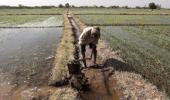Under the Bhavantar Bhugtan Yojana, the state pays a portion of the loss incurred by farmers for selling below the MSP, capped up to a limit.

The Centre will carefully evaluate all the pros and cons of the three procurement models suggested by the NITI Aayog and others to ensure procurement under the minimum support price (MSP) before finalising their contours, senior officials said.
It might commission a study to analyse the effectiveness and problems in Madhya Pradesh’s (MP’s) Bhavantar Bhugtan Yojana (price deficiency payment scheme), one of the models being talked about as an alternative to direct procurement of commodities whose prices have fallen below the fixed MSP.
The study could be done by one of the established think tanks in the country.
Under the Bhavantar Bhugtan Yojana, the state pays a portion of the loss incurred by farmers for selling below the MSP, capped up to a limit.
The state started the scheme from the 2017 kharif season and was planning to carry it into the next rabi season as well but had to abruptly withdraw the main commodities after the Centre declined financial support awaiting a formal national roll-out.
The scheme, being studied by other states, has been plagued with allegations of malfunctioning and hijacking by traders.
The other model which the Centre is trying to push is a more direct model of purchase wherein states are free to purchase commodities if prices fall below the MSP, while the Centre shares a portion of the loss.
Called the Market Assurance Scheme (MAS), it gave operational freedom to states to intervene in the market in case of a fall in prices.
Finance Minister Arun Jaitley in his 201819 Budget speech, while announcing that all MSP would be inprinciple fixed at 50 per cent more than their cost of production (A2+FL), also directed the Aayog to finalise a procurement model which would ensure maximum farmers get the benefit of the MSP.
Therefore, the Aayog has come out with a concept paper that highlights the three models of procurement that include MAS, price deficiency payment, and procurement by private agencies.
The paper was finalised after extensive discussion with states. Under the MAS, according to the Aayog paper, expenditure could be between Rs 40,500 crore and Rs 54,000 crore annually, depending upon the extent of loss shared, while under the price deficiency payment scheme, expenditure is expected to be less than Rs 30,000 crore.
However, central government officials said the expenditure could be much less, somewhere around Rs 200.25 trillion.
The third model, which is also being discussed, is the active involvement of private players to procure at the MSP. The private parties are selected through a transparent process.
Photograph: Reuters












 © 2025
© 2025